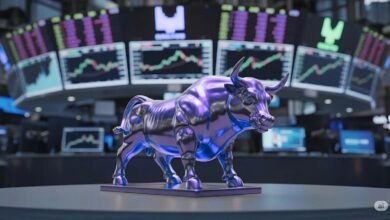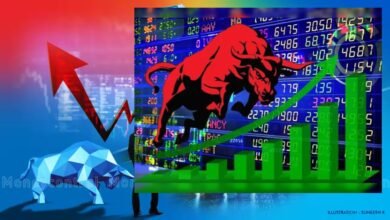Trump’s Tariff Tsunami: Inside the Historic 750-Point Sensex Reversal That Shook Dalal Street
A blow-by-blow account of the panic, the pivot, and the profound resilience that saw the Nifty defy a geopolitical shockwave and prove the dawn of a new Indian market era.

The Morning the Market Held its Breath
It began not with a bang, but with a bloodbath. Across millions of trading screens in India, a wave of crimson washed over the tickers. You felt it, didn’t you? That familiar, gut-wrenching lurch in your stomach as the numbers turned from a hopeful green to a terrifying, cascading red.
The Nifty 50, which had been flirting with historic highs, seemed to fall off a cliff. The Sensex, the very heartbeat of the Indian economy, was in freefall. Within the first hour of trade, the collective wealth of a nation seemed to be evaporating into the digital ether. The culprit? A single, earth-shaking headline that had ripped across the globe while India slept: The White House had announced an unexpected, punitive 25% additional tariff on a wide range of Indian exports.
The market, in its brutal, instantaneous wisdom, priced in the worst. It priced in a trade war. It priced in collapsing export revenues for our IT and pharma giants. It priced in a wounded rupee and a spooked foreign investor. The bears were out of their caves, and they were roaring. At its nad horário, the Sensex had bled over 750 points from its previous close, a chasm of red that seemed impossible to bridge.
And then, something extraordinary happened.
Slowly, almost imperceptibly at first, the fall arrested. A floor was found. A quiet, determined buying began to emerge from the depths. The panic selling began to be absorbed by a wall of conviction. By the time the closing bell rang at 3:30 PM, the market wasn’t just off its knees—it was standing tall. The Sensex had miraculously clawed back every single one of those 750 points from its intraday low to turn positive. The Nifty 50, once staring into the abyss, was proudly perched above the crucial 24,550 mark.
This was not just a recovery; it was a declaration. It was a boxing match where the Indian market took a knockout punch in the first round, only to get up, shake its head, and win the fight.
Today, we will go beyond the numbers. We will dissect this historic, whiplash-inducing day. We will explore the anatomy of the morning panic, identify the powerful forces that engineered the stunning turnaround, and ask the most important question of all: Does August 7, 2025, mark the day the Indian stock market finally came of age, proving it could absorb a global shockwave and stand on its own two feet?
Section 1: The Anatomy of a Shockwave – Deconstructing the Tariff Panic
To understand the recovery, we must first respect the fear. The news of a blanket 25% tariff was not just another headline; it was a direct assault on the engine room of India’s growth story. The market’s initial reaction was not irrational—it was a logical pricing-in of severe, tangible risks.
1. The Export Engine Under Siege:
For years, a key pillar of India’s economic narrative has been its prowess as a global service and manufacturing hub. A 25% tariff acts as a direct tax on this competence.
IT and ITeS Sector: Companies like TCS, Infosys, and Wipro, which derive a massive chunk of their revenue from the US, were immediately in the firing line. The market calculated that such a tariff would either have to be absorbed, crushing their world-class margins, or passed on to clients, making them uncompetitive.
Pharmaceuticals: India, the “pharmacy of the world,” faced a similar existential threat. Our pharma giants who export billions of dollars worth of generic drugs to the US were looking at a sudden, crippling blow to their business model.
Engineering Goods, Textiles, and Auto Ancillaries: These sectors, which were just beginning to gain significant traction under the “Make in India” initiative, were also caught in the crossfire.
2. The Fear of Foreign Capital Flight:
For decades, the Indian market’s direction has been heavily influenced by the whims of Foreign Institutional Investors (FIIs). A trade war with the world’s largest economy is precisely the kind of geopolitical risk that sends FIIs running for the safety of US Treasury bonds. The morning’s sell-off was amplified by the fear that the “hot money” that had fueled the recent rally would vanish overnight, leaving a vacuum.
3. The Currency Crisis Fear:
A trade shock almost always translates to currency weakness. A fall in exports means lower dollar inflows, which in turn puts pressure on the Indian Rupee. A falling Rupee imports inflation, forces the RBI to consider rate hikes, and hurts corporate balance sheets with foreign debt. The market was pricing in this entire domino effect in a matter of minutes.
The initial 750-point plunge in the Sensex wasn’t just a number; it was the combined weight of all these fears. It was the market’s gut reaction to a future that suddenly looked darker, more uncertain, and far more hostile.
Section 2: The Great Reversal – The Four Pillars of Indian Resilience
So, what happened? How did a market on the verge of a systemic crash pull off one of the most stunning intraday reversals in recent memory?
The answer lies not in a single factor, but in the convergence of four powerful pillars of a new, more robust Indian market structure. This wasn’t luck; it was the result of a decade of structural changes finally bearing fruit on their most important test day.
Pillar 1: The Domestic Fortress – The Rise of the Indian Investor
This is, without a doubt, the single most important part of today’s story. The age-old dynamic of FIIs selling and the market collapsing has been irrevocably broken. In its place is a new reality: the rise of the Domestic Institutional Investor (DII) and the retail investor.
The SIP Tsunami: The Systematic Investment Plan (SIP) has transformed from a niche product into a financial movement. Every month, tens of thousands of crores of domestic money now flow into the market with clockwork precision, managed by Indian mutual funds. This isn’t “hot money” that flees at the first sign of trouble; it is patient, long-term capital. When the FIIs were selling in a panic this morning, it was the Indian mutual funds, armed with this domestic firepower, who stepped in as buyers. They saw the panic not as a reason to sell, but as a golden opportunity to buy quality Indian companies at a discount.
The Retail Revolution: The pandemic-era boom in new Demat accounts has created a larger, more informed, and surprisingly resilient base of retail investors. While many undoubtedly panicked, a significant and growing cohort has learned the “Buy the Dip” mantra. They saw the fear, but they also saw the long-term India story and chose to bet on it.
Today, the domestic fortress stood unbreached. It absorbed the foreign selling and threw it right back. This is the new paradigm.
Pillar 2: The Muscle of Maturity – We’ve Seen This Movie Before
A market, like a person, develops resilience through experience. The Indian market of 2025 is not the fragile market of 2008 or even the startled market of early 2020. It has weathered global financial crises, demonetization, and a full-blown pandemic.
This institutional memory creates a powerful psychological backstop. Seasoned traders and investors knew that geopolitical headlines often cause exaggerated initial reactions that correct over time. They remembered past trade spats that were eventually resolved through diplomacy. This experience tempered the panic. Instead of a mindless “sell everything” cascade, there was a more calculated response: “Let’s wait for clarity. The initial shock is often the worst.” This maturity prevented the circuit breakers from tripping and allowed cooler heads to prevail.
Pillar 3: The Economic Moat – The Power of Domestic Consumption
While the tariff threat was aimed at India’s external-facing sectors, investors quickly pivoted to the other side of the coin: India’s massive, insulated domestic economy.
The market did a quick, brutal triage.
Sell: Export-heavy IT, Pharma, Textiles.
Buy: Domestic-facing Banks, FMCG, Infrastructure, and Telecom.
Investors realized that while an Infosys or a Dr. Reddy’s would be hurt, a HDFC Bank, a Hindustan Unilever, or a Reliance Industries would be far less affected. The majority of their business comes from the 1.4 billion people within India’s borders. This powerful sectoral rotation acted as a huge stabilizing force. Money flowed out of the vulnerable sectors and straight into the resilient ones, cushioning the fall of the overall index and providing the fuel for the eventual recovery. The market recognized that India’s primary growth engine is now its own internal consumption, a powerful moat that a foreign tariff cannot easily breach.
Pillar 4: The Voice of Reason – Calming Nerves and Technical Support
As the day progressed, two other factors played a crucial role.
Official Murmurs: While no formal statement was immediately issued, whispers from North Block and Mint Street likely filtered through to the major trading desks. The probable message? “This is a shock, but it is manageable. Retaliation will be measured, and diplomatic channels are open.” In a vacuum of information, even the slightest hint of a calm, calculated response from policymakers can act as a powerful antidote to panic.
Technical Levels: The Nifty and Sensex didn’t fall into a bottomless pit; they fell to key technical support levels—like a 50-day or 100-day moving average. These are levels where automated algorithms and institutional traders have pre-programmed “buy” orders. As the indices hit these levels, a wave of technical buying provided the initial bounce, giving fundamental buyers the confidence to step in and build on that momentum.
Section 3: The Investor’s Playbook – Lessons from the Whiplash
A day like today is the ultimate teacher. It provides a compressed, high-stakes course in market psychology and portfolio strategy. What are the key takeaways for you, the investor?
1. The Cost of Panic is Always Higher Than the Cost of Patience:
The investors who sold in a blind panic at 9:30 AM locked in severe losses. The investors who took a deep breath, trusted their research, and waited, saw their portfolios recover entirely by 3:30 PM. The most expensive decision you could have made today was to give in to fear.
2. Your Portfolio’s Balance is Your Only True Shield:
Today was a brutal lesson in the importance of diversification. An investor holding only IT and pharma stocks had a catastrophic day. An investor with a balanced portfolio of exporters and domestic champions felt the shock but also participated fully in the recovery. Your defense against a black swan event like a tariff is not market timing; it is thoughtful asset allocation.
3. Volatility is the Price of Admission for Wealth Creation:
If you want the long-term returns that equity markets provide, you must be willing to endure days like this. View this volatility not as a risk, but as the fee you pay for the opportunity to compound your wealth over time. The 750-point swing wasn’t a flaw in the system; it is the system. Learning to stomach it is the key to long-term success.
4. A “Buy the Dip” Strategy Needs a Strong Stomach and Deep Conviction:
The investors who made the most money today were those who bought when the fear was at its peak. This is an incredibly difficult thing to do. It requires not just capital, but immense conviction in the long-term story. It’s a strategy that should only be employed if you have a long time horizon and a deep understanding of what you are buying.
Conclusion: A Declaration of Independence
The story of August 7, 2025, will be told for years to come on Dalal Street. It was the day the Indian market was hit by a geopolitical tsunami and refused to be washed away.
The spectacular 750-point recovery of the Sensex and the Nifty’s confident stand above 24,550 were more than just a technical rebound. It was a fundamental validation of the new India story. It was a testament to the power of the domestic investor, the maturity of our market institutions, and the enduring strength of our internal economy.
The FIIs are no longer the only masters of our market’s destiny. The remote control that once lay in New York and London now has a powerful counterpart in Mumbai, powered by the savings of millions of ordinary Indians.
Today, the market did not just recover its losses. It recovered its sovereignty. It sent a clear message to the world: We are open for business, but we are no longer at your mercy. We have built a fortress, and its walls are strong.
(Disclaimer: This article is for informational and educational purposes only. It does not constitute financial advice or a recommendation to buy or sell any securities. Please consult with a qualified financial advisor before making any investment decisions.)





